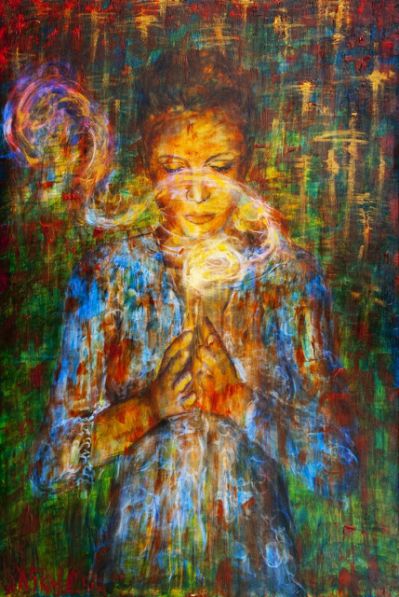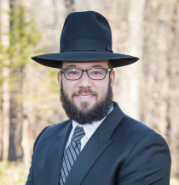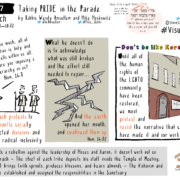Graceful Beauty / Graceful Masculinity: Chayyei Sarah
 Part of a periodic Torah series on graceful masculinity and Jewish values.
Part of a periodic Torah series on graceful masculinity and Jewish values.
וַיִּהְיוּ חַיֵּי שָׂרָה, מֵאָה שָׁנָה וְעֶשְׂרִים שָׁנָה וְשֶׁבַע שָׁנִים–שְׁנֵי, חַיֵּי שָׂרָה.
The life of Sarah was one hundred years, and twenty years, and seven years, these were the years of Sarah’s life. (Genesis 23:1)
The parsha opens with the story of Sarah’s death, but it begins with a description of her life. There are two unusual aspects to this verse, both of which have made it a particularly fruitful site for exegesis. First there is the fact that the verse references the life of Sarah twice. Rashi explains that the repetition is coming to praise her, and teach us that the years of her life “were all equal for goodness.” The first word, וַיִּהְיוּ, is a palindrome reflecting this teaching that from beginning to end, and everything in between, Sarah’s life was equally good. This is an unusual assertion as Sarah’s life certainly had its ups and downs. After struggling with infertility for decades, miraculously having a son at 90 must have felt like a life changing experience. The first word of the verse, having a numerical value of 37, also signifies this distinction by highlighting her 37 years of being a mother.
The Sefas Emes1 writes that Sarah’s days were all equally good because she was able to place G-d in front of her, always. Her clarity and awareness of G-d’s presence was so real and consistent, it was powerful enough to heal from the trauma of the original sin. R’ Gedilah Schorr taught that this is alluded to in the verse “She bestows goodness, never evil, all the days of her life.”2 There was no mixture. Nothing impure.
Second, our verse also notes that Sarah was one hundred years and twenty years and seven years old, instead of saying more efficiently that she was one hundred and twenty-seven years old. Rashi comments that this alludes to the fact that when she was 20 years old she was like a seven year old with regard to beauty. Admittedly it is a very strange compliment. What is the Torah trying to teach us is praising her in this way?
Sarah’s beauty is lauded repeatedly in the Torah, prompting Abraham to fear that he would be killed by men who coveted her. The Talmud3 explains that one of the reasons that Sarah was also called Yischah, in Genesis 11:29, was because everyone wanted to gaze at her beauty.4 Yet despite her reputation for being gorgeous, the Midrash5 claims that Abraham eulogized Sarah with the words from King Solomon’s Woman of Valor6 which include: “Grace (Chein) is false and beauty meaningless, but a woman who is God fearing should be praised.” Why is the Torah focusing on Sarah’s beauty if ultimately, beauty is not of true value?
The Torah is not singing her praises as much as it is praising her song. Whether high or low, she is consistently connecting to G-d. The rabbis observe7 that the word for song שיר / shir is the same letters as straight ישר / yashar. Songs, like life, consist of changes. Wherever we are, we can respond by connecting straight to G-d. The Talmud8 explains the verse in Psalms9“I will sing of loving-kindness and justice; unto You, O Lord, will I sing praises” to mean: If it is loving-kindness, I will sing, and if it is justice, I will sing.
Sarah was exceptionally beautiful because she presented as the purest form of the divine image, like the natural holiness of a child. Expressing that connection constantly is what made her life good. When the physical is elevated, in service of heaven, then the physical is also praiseworthy, because it is being used as a tool for spirituality.
Rabbi Akiva teaches10 that Esther merited to rule over 127 provinces of the Persian Empire because she was the descendant of Sarah who lived 127 years. Sarah modeled an embodied revelation of the hidden that continues to give strength, especially in the hard times of exile and G-d’s hiding.
Rabbi Tzvi Elimelech of Dinov11(1783-1841) explains that Rebecca and Miriam also had this spiritual beauty that inspired people to connect more deeply to G-d. Unlike the superficial beauty, true chein/grace produces a transcendent attraction that draws us closer to G-d, and to a deeper understanding of each other.
We read this Parsha on the Shabbat that we bless the upcoming month of Kislev. In Hebrew כסלו is understood as כס-לו a covering for the 36 hidden lights of Chanukah which we experience at the end of the month. Each month is connected to a different order of the four letters of G-’s name. Kislev’s is organized ויה-ה 12 the same as the last letter in the first four words of our initial verse, וַיִּהְיוּ חַיֵּי שָׂרָה, מֵאָה and corresponds to the mourning of Jacob,13 who is brought for burial in the cave on Chanukah.14
As we enter into the dark winter months, may the light of our connection to the Divine shine forth and bring true beauty to the world.
1.656↩
2. Proverbs 31:12↩
3. Bavli Megillah 14a↩
4.Another reason that is offered is that she saw with Divine Spirit↩
5. Tanchuma 4↩
6. Proverbs 31:10↩
7. Sefas Emes 633 Beshalach ↩
8. Bavli Brachos 60b↩
9. 101:1↩
10. Bereishit Rabbah 58:3↩
11. Igra D’Kallah↩
12. Beni Yissascher M’1↩
13. Genesis 50:11 וַיַּרְא יוֹשֵׁב הָאָרֶץ הַכְּנַעֲנִי↩
14. Emunas Asecha↩

By Rabbi Mike Moskowitz.









